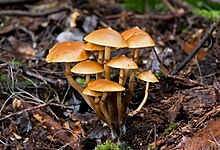
Armillaria is a genus of fungi that includes the A. mellea species known as honey fungi that live on trees and woody shrubs. It includes about 10 species formerly categorized summarily as A. mellea. Armillarias are long-lived and form the largest living fungi in the world. The largest known organism covers more than 3.4 square miles (8.8 km2) in Oregon's Malheur National Forest and is estimated to be 2,500 years old. Some species of Armillaria display bioluminescence, resulting in foxfire.

Amanita phalloides, commonly known as the death cap, is a deadly poisonous basidiomycete fungus, one of many in the genus Amanita. Widely distributed across Europe, but introduced to other parts of the world since the late twentieth century, A. phalloides forms ectomycorrhizas with various broadleaved trees. In some cases, the death cap has been introduced to new regions with the cultivation of non-native species of oak, chestnut, and pine. The large fruiting bodies (mushrooms) appear in summer and autumn; the caps are generally greenish in colour with a white stipe and gills. The cap colour is variable, including white forms, and is thus not a reliable identifier.
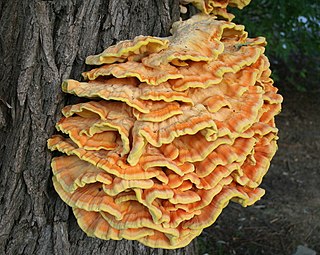
Laetiporus is a genus of edible mushrooms found throughout much of the world. Some species, especially Laetiporus sulphureus, are commonly known as sulphur shelf, chicken of the woods, the chicken mushroom, or the chicken fungus because it is often described as tasting like and having a texture similar to that of chicken meat.

Mushroom poisoning is poisoning resulting from the ingestion of mushrooms that contain toxic substances. Symptoms can vary from slight gastrointestinal discomfort to death in about 10 days. Mushroom toxins are secondary metabolites produced by the fungus.
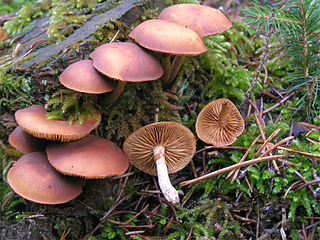
Galerina is a genus of small brown-spore saprobic fungi, with over 300 species found throughout the world from the far north to remote Macquarie Island in the Southern Ocean. The genus is most noted for some extremely poisonous species which are occasionally confused with hallucinogenic species of Psilocybe. Species are typically small and hygrophanous, with a slender and brittle stem. They are often found growing on wood, and when on the ground have a preference for mossy habitats.

Neolentinus is a genus of wood-decaying agarics with tough fruit bodies composed of dimitic tissue, serrated lamella edges, and nonamyloid white binucleate basidiospores among other features. It was segregated from Lentinus in the broad taxonomic sense, hence the derivation of the name. Biologically Neolentinus species produce a brown rot type of decay of wood, whereas Lentinus causes a white rot. Molecular phylogenetic analysis shows that the two genera are unrelated. Neolentinus is phylogenetically allied to other brown rot genera such as Gloeophyllum, Heliocybe, and Veluticeps. A new order, the Gloeophyllales, has been described for these fungi. Heliocybe had been placed in synonymy but it differs phylogenetically and anatomically by the lack of clamp connections that all Neolentinus produce on their generative hyphae.

Mycoremediation is a form of bioremediation in which fungi-based remediation methods are used to decontaminate the environment. Fungi have been proven to be a cheap, effective and environmentally sound way for removing a wide array of contaminants from damaged environments or wastewater. These contaminants include heavy metals, organic pollutants, textile dyes, leather tanning chemicals and wastewater, petroleum fuels, polycyclic aromatic hydrocarbons, pharmaceuticals and personal care products, pesticides and herbicides in land, fresh water, and marine environments.
Amatoxin is the collective name of a subgroup of at least nine related toxic compounds found in three genera of poisonous mushrooms and one species of the genus Pholiotina. Amatoxins are very potent, as little as half a mushroom cap can cause severe liver injury if swallowed.

Gymnopilus is a genus of gilled mushrooms within the fungal family Hymenogastraceae containing over 200 rusty-orange spored mushroom species.

Conocybe is a genus of mushrooms with Conocybe tenera as the type species and at least 243 other species. There are at least 50 different species in North America.
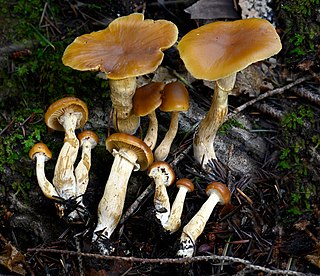
Galerina marginata, known colloquially as funeral bell, deadly skullcap, autumn skullcap or deadly galerina, is a species of extremely poisonous mushroom-forming fungus in the family Hymenogastraceae of the order Agaricales. It contains the same deadly amatoxins found in the death cap. Ingestion in toxic amounts causes severe liver damage with vomiting, diarrhea, hypothermia, and eventual death if not treated rapidly. About ten poisonings have been attributed to the species now grouped as G. marginata over the last century.

Pholiotina cyanopus is a species of fungus that contains psychoactive compounds including psilocybin and the uncommon aeruginascin. Originally described as Galerula cyanopus by American mycologist George Francis Atkinson in 1918. It was transferred to Conocybe by Robert Kühner in 1935 before being transferred to Pholiotina by Rolf Singer in 1950. A 2013 molecular phylogenetics study found it to belong to a group of species currently assigned to Pholiotina that are more closely related to Galerella nigeriensis than to Pholiotina or Conocybe. It is likely that it will be moved to a different genus in the future, but this has not happened yet.

Amanita ocreata, commonly known as the death angel, destroying angel, angel of death or more precisely western North American destroying angel, is a deadly poisonous basidiomycete fungus, one of many in the genus Amanita. The large fruiting bodies generally appear in spring; the cap may be white or ochre and often develops a brownish centre, while the stipe, ring, gill and volva are all white. A. ocreata resemble several edible species commonly consumed by humans, increasing the risk of accidental poisoning. Mature fruiting bodies can be confused with the edible A. velosa, A. lanei or Volvopluteus gloiocephalus, while immature specimens may be difficult to distinguish from edible Agaricus mushrooms or puffballs.

Daedalea quercina is a species of mushroom in the order Polyporales, and the type species of the genus Daedalea. Commonly known as the oak mazegill or maze-gill fungus, the specific epithet refers to the oak genus Quercus, upon which it frequently grows, causing a brown rot. It is found in Europe, Asia, Northern Africa and Australasia. Though inedible, it can be used as a natural comb and has been the subject of chemical research.

Galerina sulciceps is a dangerously toxic species of fungus in the family Strophariaceae, of the order Agaricales. It is distributed in tropical Indonesia and India, but has reportedly been found fruiting in European greenhouses on occasion. More toxic than the deathcap, G. sulciceps has been shown to contain the toxins alpha- (α-), beta- (β-) and gamma- (γ-) amanitin; a series of poisonings in Indonesia in the 1930s resulted in 14 deaths from the consumption of this species. It has a typical "little brown mushroom" appearance, with few obvious external characteristics to help distinguish it from many other similar nondescript brown species. The fruit bodies of the fungus are tawny to ochre, deepening to reddish-brown at the base of the stem. The gills are well-separated, and there is no ring present on the stem.

Amanita bisporigera is a deadly poisonous species of fungus in the family Amanitaceae. It is commonly known as the eastern destroying angel amanita, the eastern North American destroying angel or just as the destroying angel, although the fungus shares this latter name with three other lethal white Amanita species, A. ocreata, A. verna and A. virosa. The mushroom has a smooth white cap that can reach up to 10 centimetres across and a stipe up to 14 cm tall with a white skirt-like ring near the top. The bulbous stipe base is covered with a membranous sac-like volva. The white gills are free from attachment to the stalk and crowded closely together. As the species name suggests, A. bisporigera typically bears two spores on the basidia, although this characteristic is not immutable. A. bisporigera closely resembles a few other white amanitas, including the equally deadly A. virosa and A. verna.

Amanita exitialis, also known as the Guangzhou destroying angel, is a mushroom of the large genus Amanita. It is distributed in eastern Asia, and probably also in India where it has been misidentified as A. verna. Deadly poisonous, it is a member of section Phalloideae and related to the death cap A. phalloides. The fruit bodies (mushrooms) are white, small to medium-sized with caps up to 7 cm (2.8 in) in diameter, a somewhat friable ring and a firm volva. Unlike most agaric mushrooms which typically have four-spored basidia, the basidia of A. exitialis are almost entirely two-spored. Eight people were fatally poisoned in China after consuming the mushroom in 2000, and another 20 have been fatally poisoned since that incident. Molecular analysis shows that the species has a close phylogenetic relationship with three other toxic white Amanitas: A. subjunquillea var. alba, A. virosa and A. bisporigera.
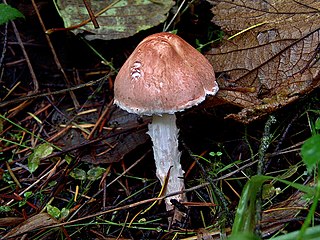
Lepiota subincarnata, commonly known as the deadly parasol, is a gilled mushroom of the genus Lepiota in the order Agaricales. It is known to contain amatoxins and consuming this fungus can be potentially lethal. The species is found in Asia, Europe, and North America, in woods as well as richly soiled parks. It was first described scientifically by the Danish mycologist Jakob Emanuel Lange in 1940. Bon and Boiffard described Lepiota josserandii in 1974, which turned out to be the same species.

Amanita fuliginea, commonly known as the east Asian brown death cap, is a species of deadly poisonous mushroom in the family Amanitaceae. The fruit bodies have convex, dark gray to blackish caps measuring 3–6 cm (1.2–2.4 in) in diameter. The gills, largely free from attachment to the stipe, are white and have short gills (lamellulae) interspersed. The spores are roughly spherical, amyloid, and typically measure 8–11 by 7–9.5 µm. The species was described as new to science by Japanese mycologist Tsuguo Hongo in 1953. A. fuliginea is classified in Amanita section Phalloideae, which contains the infamous destroying angel.
